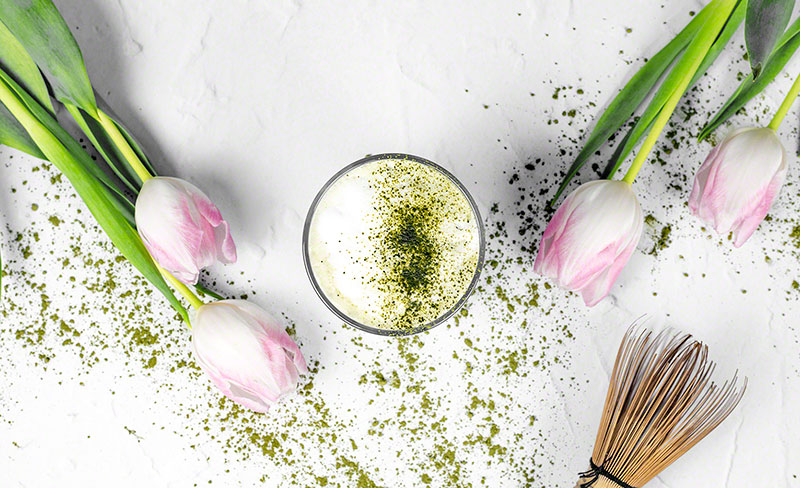How to Make A Homemade Matcha Latte
If you are looking for the best substitute for a regular morning latte, matcha may be the right answer. It’s not only easy to make, it’s delicious, doesn’t need any sweetener, contains caffeine and numerous potential health benefits.
Homemade matcha latte
There are two ways to make matcha latte at home. For the easy recipe all you need is a small saucepan, one regular teaspoon, fine mesh sifter, a milk of choice and a frother. We suggest investing into a small electric hand frother that will come in handy when making latte drinks.
Why would you drink a matcha latte in the first place? Matcha is a high quality green tea powder rich in antioxidants, tastes delicious and can give you sustainable energy throughout several hours. Unlike coffee, it won’t cause the jitters. Some studies suggested that drinking matcha may help boost fat burn, increase energy, memory and performance. As you drink the whole leaf, rather than steeping it, you ingest all nutrients, not only those released into water. There are different types of matcha tea grades–culinary, latte and ceremonial, but all of them are suitable for making lattes.
How to make a matcha latte
To make matcha latte you will need:
- 1 teaspoon of matcha powder (levelled to rounded, depending on the type of powder you are using)
- 20-30 ml of water for making a paste with a spoon, or 50-70 (about ¼ cup) if you want to use bamboo whisk or chasen
- 150 ml of milk (about ¾ cup)
- Sweetener
Chasen or matcha whisk, chawan or matcha tea bowl and shashaku or matcha scoop are traditional utensils for preparing matcha tea. They are indispensable if you want to enjoy the best cup. However, for making lattes, they are not required and you can make a delicious drink by using regular kitchen utensils.
Which matcha type should you use for making latte?
The type of matcha you choose is more important for making traditional tea, than for making a latte. There are different grading system for matcha powder, and the two main categories include ceremonial grade and latte and culinary grade matcha. The best type for making a non-traditional matcha drink is a latte grade matcha, but you can use culinary grade matcha and ceremonial grade matcha too.
If you have a very high quality expensive ceremonial grade matcha, we recommend drinking it without milk. Basically, the difference between culinary and latte and culinary grade is that the first one will still give a delicious taste while blended with milk, and the second one is more suitable for cooking, should be used in larger amount to get the best flavor and color and is often less expensive. You may be able to use latte grade for drinking matcha in the traditional way, but you won’t get as enjoyable drink if you use a cooking grade powder.
The easiest way to make matcha latte at home
- Bring fresh spring water to a boil and let it cool down to 185°F
- Sift matcha powder directly to your mug to break the lumps
- Add water and use a teaspoon to create a paste
- In a saucepan, boil the milk and use electric frother to create froth
- Pour the milk into your cup with matcha paste and stir
- Add sweetener
For making matcha using traditional teaware
- Bring fresh spring water to a boil and let it cool down to 185°F
- Sift matcha powder directly into your mug or bowl to break the lumps
- Add water and whisk making W movements until all powder is dissolved
- In a small saucepan, boil the milk and use electric frother to create froth
- Pour the milk into your cup with matcha and stir
- Add sweetener
Never use bamboo whisk to froth the milk. Use either regular or electric milk frother or even a blender. Prongs on chasen can be destroyed very easily in hot boiling milk, and it will be difficult to remove the milk scent later.
Best milk and sweetener combinations:
- Milk and sweetener ideas:
- Coconut milk + coconut sugar
- Almond milk + maple syrup
- Cashew milk + honey
Alternative powders
Don’t have a matcha powder? You can easily make your own tea powder at home and use it for making lattes. The best tea for making a green tea powder would be either gyokuro or Japanese sencha. They have just the right amount of both sweetness and astringency, and a desirable umami note. Although the real matcha powder doesn’t contain any stalks, veins and stems and has a much finer grain size than the home-made powder, it’s still possible to get a great latte. You can try using a coffee grinder and a mortar and pestle.
Grind the loose leaf tea for a few minutes in a blender, stopping and shaking it every 10 seconds or so. If your grinder doesn’t produce fine grains, break it even more using a mortar and pestle. Sift the powder and store in a clean airtight container. You can use only a mortar and pestle too, but it will be more time consuming and will require a lot of effort to get the fine powder. The good part? Most stalks and stems will be left whole, and you can easily remove them from your powder.
Read about matcha tea benefits here.
Disclaimer: This article is for informational purposes only. It’s not intended to replace medical advice, diagnosis or treatment. Every person is different and may react to different herbs and teas differently. Never use teas or herbs to treat serious medical conditions on your own. Always seek professional medical advice before choosing home remedies.




